Tag: Nelson County Virginia
Spring in the Vineyard
Cab Franc vines, still protected by mounds of dirt, showing exuberant growth before being un-hilled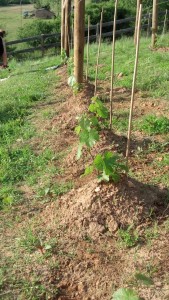
Despite months of crazy weather, it's finally springtime in the vineyard. And after all the hours of planning and research and all the work that went into getting the vineyard ready for planting vines – not to mention the planting itself – I was pretty bummed about not getting to see the early fruits of our labor this weekend. My wife, Chris, ably assisted by daughter Kate, the vineyard volunteer worker, traveled to Afton without me this weekend to un-hill new vines, continue the work on the deer fence, and handle a dozen other tasks that demand attention in the spring.
So, this isn’t exactly an eyes-on report from the scene. It’s more like something cobbled together by an editor hunkered down in a newsroom, piecing together a story out of dispatches sent in by reporters from the front lines. I've been both a reporter and an editor in my life, and believe me, being a reporter is way more fun. Editors sit behind desks in newsrooms waiting for reporters to tell them what’s going on. When I was an editor, I generally got cranky while waiting. Reporters get out of the office and see things happen. Even in the day of Blackberries and instant communication, I'm sure they still keep editors at bay during the day by telling them there’s way too much going on to stop and talk. And they’re usually right.
Petit Verdot vines after removal of the earth mounds, or hills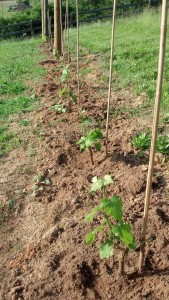
In this case, Chris and Kate filed their dispatches by text messages, emailed pictures, and a number of old-fashioned cell-phone calls, all of which provided some color on the early progress our vines are making. I have to say, we’re just thrilled with the results. Out of the 150 vines we planted this spring, only one appears to be clearly dead, according to the reports I've received, although another ten are doubtful. But the rest look magnificent! (Especially in the pictures.)
I’m particularly pleased with the progress of the first group of Cabernet Franc vines that we transplanted from our Fairfax vineyard two weeks ago. They not only survived, but they’re flourishing. And they have fruit! Big clusters of berries that will turn into grapes very soon if we leave them on the vine. Which, of course, we won’t. Even if the vines hadn’t been through the shock of being dug up in Fairfax and replanted in Afton, they’re still only in their second year of life, and they needto devote all of their energy to developing a strong root system and trunk. So we’ll be dropping the fruit soon.
Clusters of berries that would eventually be Cab Franc wine grapes if we let them continue to mature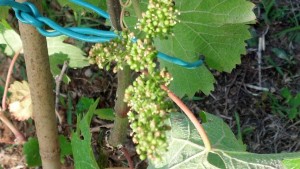
We had planted seven Cab Franc vines in Fairfax a year ago, all for the purpose of getting additional hands-on experience working with vines. This weekend, Chris dug up the last three and moved them, so the Fairfax “vineyard” is officially defunct, although it lives on in spirit in Nelson County. We can’t be sure that all seven will make it, but we’re very hopeful.
Cab Franc vines still in transplant shock from being moved on May 19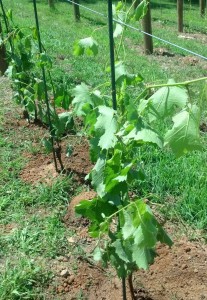
In any event, I'm glad we tried this experiment, which was prompted by an article by WineMaker’s magazine’s Wes Hagen. He recommended ordering extra vines and planting the excess closely together on some spare land. That way, you have some surplus vines to replace the ones that inevitably will die. And that’s one of the sad facts of viticulture. No matter how good you are, no matter how carefully you plant, and no matter how great the nursery you buy from, you’re going to lose some plants. So, even though some of the 50 Cab Franc vines that we planted this year will surely die, with the additional one-year old vines Fairfax we should end up ahead of the game. Wish I had read the Wes Hagen advice before we ordered vines for planting this year.
Looking at the rest of the vinyeard, our whites are doing quite well. We planted 25 each of Petit Manseng and Viognier on the weekend of March 31, and mounded hills of earth over them, covering the graft union with about two inches of soil to protect the dormant vines from the possibility of late frost. We un-hilled them two weekends ago on May 6, and they have been doing quite well ever since.
Close up of a Petit Manseng vine that was planted April 21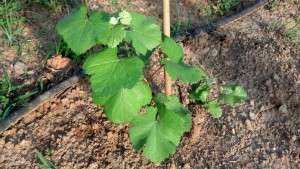
Likewise, the reds are showing great promise. Chris and Kate un-hilled the 100 Cab Franc and Petit Verdot vines that we planted over three days in early April. Both grapes seem to do well in Virginia, and we are wildly optimistic about their potential. Which, of course, puts us in the company of farmers everywhere who start each spring full of optimism, no matter how bad the previous year went. And don’t get anyone started talking about the 2011 vintage. Trust me, just don’t.
A row of Viognier vines - all healthy so far!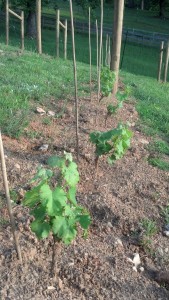
By the way, the un-hilling I did two weeks ago involved a lot of careful work with my hands, but it was positively crude compared to Chris’s method. I pushed the dirt aside a little bit at a time, until the vine was completely uncovered. Okay, maybe a spare bud or two got knocked off in the process.
Chris would have none of that. She bought a makeup brush for the final removal of soil from the vines, and claims it worked like a charm. I wasn’t there, so I’ll take her word for it. It seems like a pretty time-consuming approach, so I’m pretty confident that I’ll do my part of the un-hilling next year sans the makeup brush. Unless of course the vines she un-hilled do better than mine. Let’s not even go there, okay?
And there’s still so much work to be done. I think I’m recovering well enough from surgery that I’ll be able to be in Afton myself for the next trip. Chris and Kate have gotten to be quite the dedicated and skilled vineyard workers, handling everything from driving posts into the ground to planting vines. I’d sure like to be able to lend a hand. Or at least be there to watch with great enthusiasm while they do the work
On Deer Fences and Surgery
With the new vines in the ground and growing beautifully, the need for a deer fence was growing ever more urgent. Deer are only one of many pests that will go after the grapes once the fruit reaches a certain level of sweetness, but they will also go after the shoots themselves. With all the work we put into this small hobby vineyard, we don’t want the vines to end up becoming a McDonalds for the local deer population.
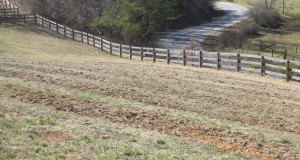
- The entire property has a three-board fence, with added wire meshing — good for keeping critters off the property, but not high enough to stop deer.
This seemed like an easier task than putting in the trellising system, but even so, we spent a fair amount of time researching deer fences over the previous month. In our division of labor, I had worked out the details on the trellis, and my wife, the Vineyard Goddess, devoted herself to the deer fence.
Traveling around area vineyards, we got a sense of the variety of fences that were being used. Some vineyards have installed metal fences as high as 10 feet, but that seemed like overkill for us.
Our property is already surrounded by a four-foot high, three-board wood fence that has a metal mesh fence attached to keep small critters out and our two Vineyard dogs in. We briefly toyed with the idea of doing something to raise the height of that fence by another four feet all around the property, but rejected that approach for two reasons.
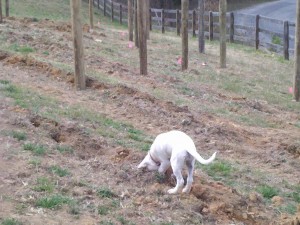
- And here Glory is demonstrating why a separate fence around the vineyard itself is absolutely essential.
First, it’s a whole lot of fence — about 1,100 feet. For about $8 a foot, we probably could have put in a fence that would be way more utilitarian than aesthetically pleasing, but this property will someday be our home, so we’re going for aesthetically pleasing. And second, while it would keep our dogs from wandering off the property, it would do absolutely nothing to keep them out of the relatively smaller vineyard area inside our property.
Phoeneix, the vineyard dog, isn’t so much of a problem by himself. He shows a certain Continue Reading–>
Building the Trellis, Part I
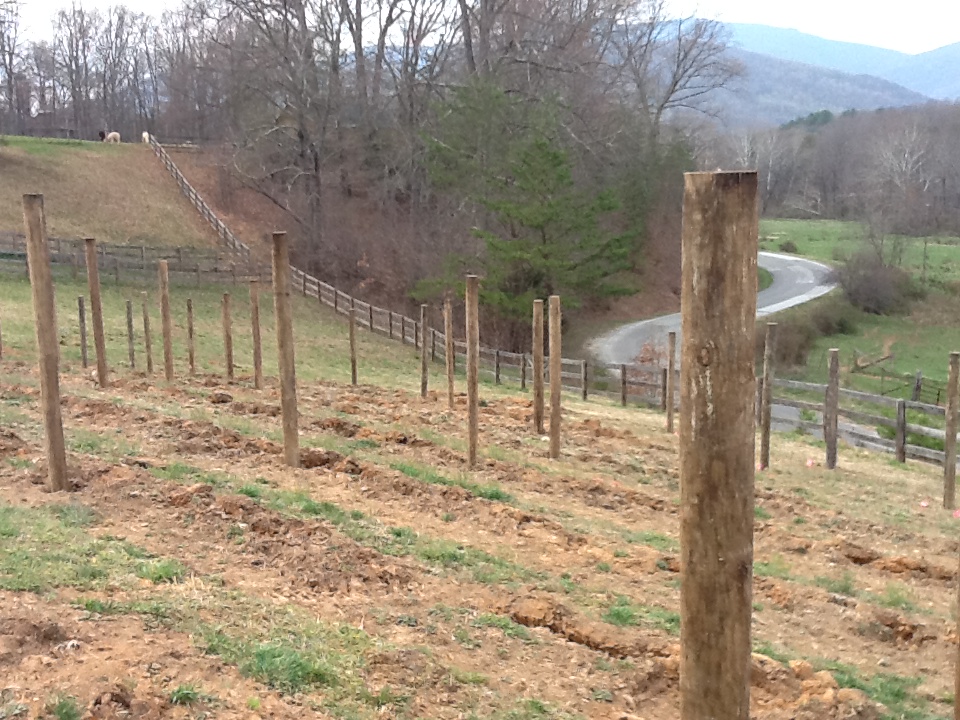
Here's how the vineyard looked last weekend, March 17. The posts are in the ground, the rows have been ripped, and it's beginning to look like a real vineyard! You can see our neighbors, the Alpacas, on the hill, top left.
How we built the trellis
Well, I have to be honest, I didn’t exactly build it myself. Much as I wanted to install the posts with my own hands, I ended up short on time with the planting season upon us. We needed to get the vines in the ground, pronto.
I’d spent much of the winter, between viticulture classes, my job and all of the work that goes into maintaining two separate properties, thinking about how to handle the trellis. There were moments when it seemed simple enough — eight foot posts put 24 to 30 inches into the ground, plus some kind of end-post system, which would be only slightly more complicated. And then, there were times when I wondered if I was up to the job.
As part of the planning, I did some research on what kind of equipment I’d need to buy or rent. A lot of the literature suggests that the best way to put posts into the ground is to pound them in, but the equipment involved would have made that impractical for me to do on my own. The easiest way to get the posts in is to drill the holes with an auger.
So, I briefly considered the idea of a hand-held power auger, which was the least expensive approach, or an auger for my tractor. I spent a lot of time visualizing the process, and considering whether it would be more cost-effective to do it myself or hire someone to do the work. I was pretty confident I could get the line posts in without a problem, but I spent a lot more time worrying about the end posts, which are more complicated. At some point, I began waking up at 4 a.m. to worry about how much work needed to be done and wonder if the vines we had ordered were destined to just, uh, rot on the vine? No, bad metaphor. Go to seed? mmmm…. no, that doesn’t work either. Wither and die? Well, something like that.
Eventually, we passed the point where I could reasonably expect that it would be Continue Reading–>
Dormant Winter Pruning — and other Vineyard Considerations
After a long winter that sometimes seemed like it would never end, spring planting is just around the corner. And despite all the time we had to prepare for the new season, we are now feeling not quite as ready as we’d like to be.
We’ve ordered 150 vines –50 Petit Verdot, 50 Cab Franc, 25 Viognier and 25 Petit Manseng – and lately I’ve been waking up in the middle of the night wondering if we’ll have everything in place in time to plant. I’m still worried, but we’ve made enough progress lately, especially this weekend, that I’m feeling a bit better about the whole enterprise.
Our biggest concern is the trellis. If you’ve followed our progress through this blog, you’ll note that I didn’t worry about that last Spring when we planted 14 vines, split between our Fairfax and Nelson county properties, but that was different on a couple of counts. First, those vines were more for our education than for the eventual production of wine. And we’ve learned a lot from taking care of those vines. Wine in two years would be a bonus, but it wasn’t the goal when we planted them. The second reason I didn’t obsess over the trellis is that I didn’t expect those vines to reach the height of the first wire in that initial year. And since there are so few Continue Reading–>
A night in the Vineyard — with Snow
Before explaing why we found outselves in the vineyard late last night with the snow coming down, let me give you a little background, which hopefully will assure you that we are not crazy. Not completely, anyhow.
In my last post, I talked about the importance of weather in vineyard management. Obviously weather is a factor in all things agricultural – there’s not a farmer in the world who doesn’t keep at least one eye on the sky throughout the growing season – but it raises very specific and difficult issues when it comes to viticulture. Vines, after all, aren’t annual crops. It takes three or more years to bring vines to the point where a crop can be harvested, and they can be be expected to bear fruit for decades after that, which means they must be nurtured through hot, humid summers and cold winters.
I also talked about the importance of site selection in my last post, and it turns out that many of the issues in selecting a vineyard property boil down to coping with weather.
For example, a late frost can cost you an entire growing season. No grapes, no wine, and (if this is your business), no money – although you’ll still have to undergo the expense of caring for the vines throughout the growing season And a serious winter freeze – one in which temperatures drop well below zero – can cost you the entire vineyard. That’s why wine-grape growers in Virginia look for property with an appropriate elevation. In much of the area east of the Blue Ridge Mountains, elevations above 800 feet are highly desirable, since they bring you into a sweet spot of a thermocline where warmer air is trapped. Optimal elevations, those within a thermal belt or thermocline, vary by region. In our area (the Monticello AVA), I believe that elevations of 800 to 1500 feet above sea level (ASL) are optimal. Any higher or lower and you risk problems from frosts and freezes. Continue Reading–>
Introducing the Vines, Part II – Meet the Nelsons
It’s long past time to introduce the Nelson County vines, but before I start, let me once again acknowledge that it’s a bit of a stretch to refer to seven vines as a vineyard. But hey, it’s a stretch I’m willing to make. One is a vine, two or more is a vineyard, right?
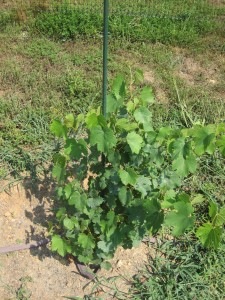
- “Nelson Mandela,” the tallest, noblest of our Cab Franc vines, named for one of the truly great figures of the 20th century.
The Nelson County property is the site for the real vineyard we plan to put in, and the seven vines we’ve planted fall into the category of experimental. As my wife, the Vineyard Goddess, puts it, we want to make our mistakes on these vines, so that we’ll know what we’re doing when we plant the main vineyard.
The vineyard itself is a small plot, surrounded by a deer fence, with five Cab Franc vines and two Mammolo Toscanos. The Cab Franc were purchased from Double A Vineyards, a nursery in New York state. They were ordered for delivery in the middle of April, a bit late in the season, but it took me a little time to get my arms around the idea that I could actually get everything done in time to plant vines this year. We ordered 12 in all, and the other seven were planted at our Fairfax property, where I thought I could keep a close eye on them. Continue Reading–>

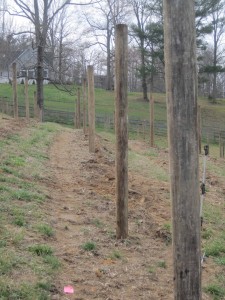
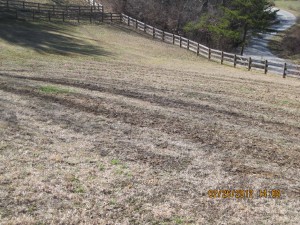
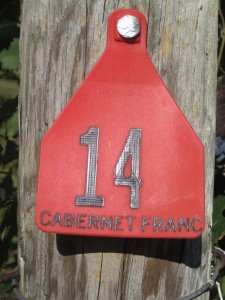
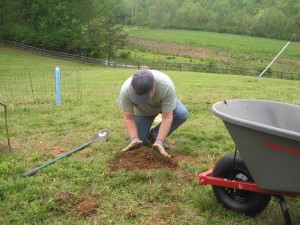


Recent Comments